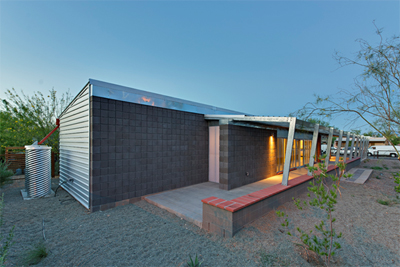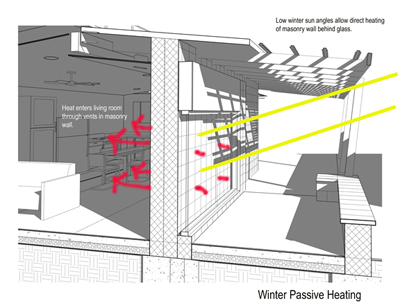IN THIS ISSUE:
Grantee Spotlight: Sustainable Design: At the Intersection of Research and Practice in Tucson
Empowerment and Inclusive Economic Development in South Los Angeles
Facilitating Community Change: Auburn University in Uniontown
Grantee Spotlight: Sustainable Design: At the Intersection of Research and Practice in Tucson
For more than 10 years, the Community Outreach Partnership Center at the University of Arizona’s Drachman Institute has been a leader in sustainable community development in the Tucson area. Drachman staff, along with students and faculty in the university’s College of Architecture, Planning and Landscape Architecture (CAPLA), have implemented projects that span the intersection of research and practice ranging from designing and building resource-efficient housing to accurately measuring housing affordability in the Tucson metropolitan area. Drachman’s innovative work has received support from the Office of University Partnerships’ Community Outreach Partnership Centers (COPC) grant program. Drachman formed its Community Outreach Partnership Center in 2003 after receiving a $400,000 COPC Futures Demonstration grant to develop resource-efficient prototype homes. In 2005, the institute received a $400,000 COPC New Directions grant to provide technical assistance to low-income neighborhoods implementing built environment projects that advance community health.
Source:
Drachman Institute. n.d. “Community Outreach Partnership Center.” Accessed 15 October 2014; U.S. Department of Housing and Urban Development, Office of University Partnerships. n.d. “Grantee Database: University of Arizona, COPC, 2005.” Accessed 15 October 2014.
×Source:
U.S. Department of Housing and Urban Development, Office of University Partnerships. n.d. “Grantee Database: University of Arizona, COPC, 2005.” Accessed 15 October 2014.
×Drachman Design-Build Coalition
Years after the COPC grants ended, the initiatives they seeded continue to bear fruit. In the spring of 2014, CAPLA students finished constructing DDBC Residence 5, the latest in a series of resource-efficient prototype homes that have been designed and built for low-income households. Known as the “Trombe Wall” house, the residence includes numerous features that promote energy efficiency, water conservation, and other sustainable design and construction practices.
Source:
Interview with Mary Hardin, associate dean and professor, College of Architecture, Planning and Landscape Architecture, University of Arizona, 21 October 2014.
×

The “Trombe Wall House” is the most recent home designed and built by the Drachman Design-Build Coalition. Credit: Liam Frederick
Completed in less than 18 months from concept to occupancy, the Trombe Wall house is a project of the Drachman Design-Build Coalition (DDBC), a professionally licensed, nonprofit real estate development affiliate of the Drachman Institute. DDBC is headed by CAPLA associate dean and professor Mary Hardin, who founded the coalition in 2004 to give architecture students experience in designing and constructing resource-efficient homes on a modest budget. These students serve as DDBC staff members and execute the institute’s design-build projects over the course of three semesters.
The Trombe Wall house is DDBC’s seventh completed project since 2006. The house takes its name from a glazed masonry wall that runs the length of the building’s southern facade. During the cool winter months, this trombe wall provides passive heating, storing the sun’s energy during the day and transferring it to the home’s interior in the evening. In the summer, the warm air is vented outside. The trombe wall is also the only exterior wall of the house with masonry construction. The remaining walls are made of insulated concrete with an R-value of 25. According to Hardin, this hybrid approach to materials reduced the labor costs associated with masonry construction, keeping the project within its $85,000 construction budget.
The COPC Futures Demonstration grant supported research into sustainable building practices that has influenced the design of the DDBC homes. A portion of the grant funded “Conservation Technologies for Affordable Housing,” a report that evaluated energy-efficiency features of built projects to determine the most cost-effective sustainable design. The grant also helped DDBC build a few of the prototype homes, and the organization has established a small revolving fund to acquire sites and secure construction financing. DDBC partners with the Tucson-based Family Housing Resources to sell the homes — five of which have been built in Barrio San Antonio — to low- and moderate-income households.
Neighborhood Planning

The trombe wall absorbs heat from the sun in the winter, helping reduce heating costs. Credit: Drachman Design-Build Coalition
Along with promoting sustainable building design, Drachman’s Community Outreach Partnership Center has also been involved in larger neighborhood planning efforts in communities across the state. The 2005 COPC New Directions grant allowed Drachman to provide low-income neighborhoods in Tucson’s Empowerment Zone with technical assistance to develop healthy neighborhood strategies such as parks, pedestrian improvements, and other enhancements to the built environment.
Over the years, Drachman has built on its research and community planning projects to respond to emerging challenges throughout the state. For example, in 2009, the Pima County Health Department and Active Tucson Coalition received a Communities Putting Prevention to Work (CPPW) grant through the American Recovery and Reinvestment Act. The grant supported Pima County’s efforts to reduce obesity and promote physical activity, including a review of conditions in the built environment that contribute to the high rates of obesity among low-income residents. Coauthored by Drachman, the report recommends programs and infrastructure investments to increase residents’ physical activity and improve their health. Building on the work that the second COPC grant supported, the CPPW grant helped advance neighborhood planning interventions throughout Tucson and highlighted the relationship among housing, neighborhoods, and public health.
Drachman’s Community Center Today
The Community Outreach Partnership Center’s work, supported in its early years with COPC grants from HUD’s Office of University Partnerships, continues today through DDBC and the research and planning projects that Drachman staff, faculty, and students undertake. Marilyn Robinson, associate director of Drachman, explains that the institute has evolved over the years to respond to the challenges facing Arizona residents. For example, the Housing + Transportation Affordability research in the Tucson area that Drachman helped lead in 2009 has spurred additional research into mixed-income development in transit locations in Pima County. DDBC is advancing sustainable building design through both research and practice while also creating infill homeownership opportunities for low- and moderate-income Tucson residents. Consistent throughout all of Drachman’s work is a commitment to meet the needs of low-income residents while conserving energy and other resources.
Source:
Interview with Marilyn Robinson, 13 October 2014; Drachman Institute. n.d. “About Drachman.” Accessed 13 October 2014.
×

